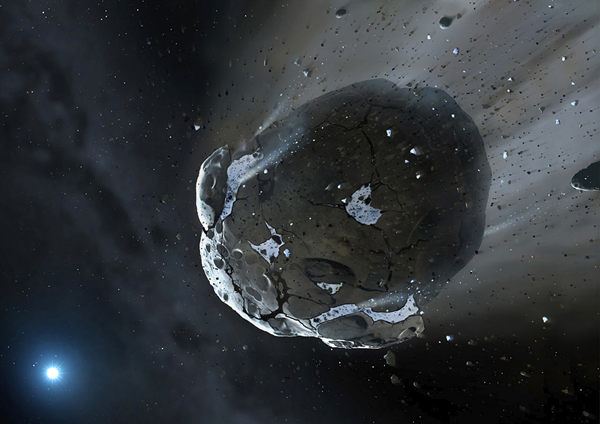Q: I’m curious about the mechanism in June’s “Water worlds in the Milky Way” that causes orbiting planets to spiral in until they are torn apart by a white dwarf. What causes them to move inward, and on what timescale?
Michael Hickman
Centerville, Texas
A: To answer these questions, we must take a step back and add a layer to the article. The best place to start is right here in the solar system.
First, when our Sun finishes fusing matter into energy, it will expand. Some astronomers call this process “death,” but really it’s a transformation, more like a caterpillar changing into a butterfly. The Sun will almost certainly engulf Mercury and Venus and consume them utterly, and while the fate of Earth is uncertain, everything exterior to Earth’s orbit will remain essentially intact. This includes Mars, the main belt of asteroids, the giant planets, and beyond. When the Sun later shrinks and heats up into an Earth-sized ember known as a white dwarf, it will remain surrounded by a fairly complex planetary system.
Second, Jupiter currently has a dramatic gravitational influence on the asteroid belt (and to a lesser degree, Neptune influences the Kuiper Belt, where Pluto and many other icy objects reside). Jupiter is basically a bully — the asteroids want to come together to form a small planet, but Jupiter keeps the potential family members separated by pushing and pulling on anything in certain regions of the main belt, emptying these areas out. The emptied regions of the main belt are called the Kirkwood gaps, and Jupiter shoves things out of the gaps via something called orbital (or mean-motion) resonances, which work like pushing someone on a swing. For example, an asteroid with a 2:1 resonance with Jupiter orbits the Sun twice for every one orbit Jupiter makes. Once every two orbits, the asteroid will line up with Jupiter, which acts like the person pushing the swing to tug the asteroid out of its original orbit, clearing the gap.
These “lost” asteroids can be ejected from the solar system, bang into another planet, or fall into the Sun. We sometimes see the latter with the Solar and Heliospheric Observatory (SOHO) and Solar TErrestrial RElations Observatory (STEREO) satellites, although these are usually small bodies, so it happens quickly. But this process certainly happens to large bodies on timescales longer than our lifetimes. In fact, the most common effect of a mean-motion resonance is to change the affected object’s orbital eccentricity, which measures how circular its orbit appears from overhead. The larger an orbit’s eccentricity, the more elliptical and less like a circle it appears.
This changing eccentricity is what astronomers envision for the tidally destroyed planetary bodies at white dwarfs. There is a surviving planetary system, and gravitational interactions between at least one planet and any surviving asteroids (or comets) lead to high-eccentricity orbits. These orbits can then intersect with the white dwarf’s Roche radius — the distance at which tidal gravity from the star tears apart any body — which will destroy the object and result in a cloud or disk of debris that will eventually rain down onto the stellar surface. This is what causes the metal pollution we observe and allows us to obtain the composition of this doomed little world.
As for the timescale, the gravitational disturbance occurs on the orbital timescale of the planetary body in question (i.e., the time it takes to complete an orbit). However, simulations have shown that this can occur right away within several million years after the white dwarf forms, and continue for many billions of years as the white dwarf gradually cools. All that is required is at least one planet and a sufficient reservoir of bodies to throw around.










